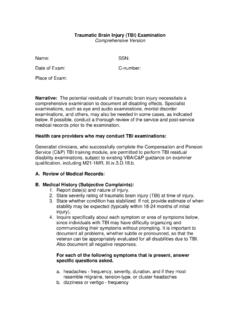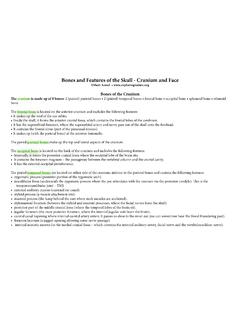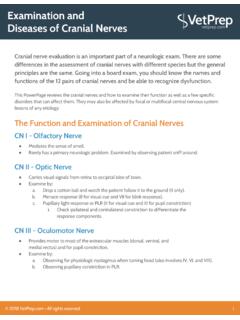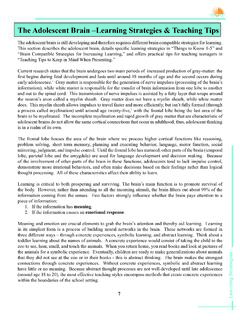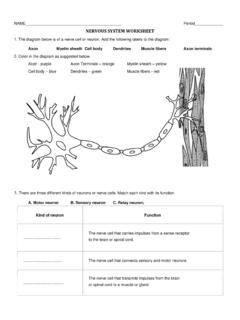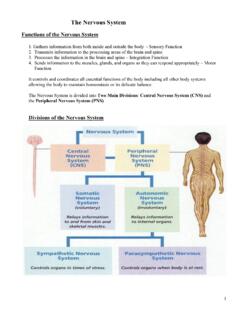Transcription of Autonomic Nervous System - Los Angeles Mission College
1 2017 Ebneshahidi Autonomic Nervous System Dr. Ali Ebneshahidi 2017 Ebneshahidi Nervous System Divisions of the Nervous System The human Nervous System consists of the central Nervous System (CNS) and the Peripheral Nervous System (PNS). CNS is composed of the brain (located in the cranial cavity) and the spinal cord (located in the vertebral cavity), which serve as the main control centers for all body activities. PNS is composed of nerves derived from the brain and spinal cord (12 pairs of cranial nerves and 31 pairs of spinal nerves) which serve as linkage between the CNS and the body. 2017 Ebneshahidi ANS Versus SNS PNS can be subdivided into sensory (afferent) nerves and motor (efferent) nerves.
2 Sensory nerves send nerve impulse from the body to CNS to effector organs. Motor nerves are divided into the somatic Nervous System (SNS) which regulates the voluntary contraction of the skeletal muscles, and Autonomic Nervous System (ANS) which regulates the involuntary control of smooth, cardiac muscles and glands. 2017 Ebneshahidi ANS Finally, the ANS can be divided into sympathetic and parasympathetic branches where in general sympathetic nerves stimulate activities of the effect or organs (except digestive organs) and parasympathetic nerves inhibit activities of the effect or organs (except digestive organs). 2017 Ebneshahidi Comparison of Somatic and Autonomic Systems 2017 Ebneshahidi ANS ANS together with the endocrine System controls the body's internal organs.
3 It innervates smooth muscles, cardiac muscle , and glands , controlling the circulation of blood , activity of the . Tract and body temp . Characteristics : 1. Innervates smooth muscle , cardiac muscle and glands of internal organs . 2. Involuntary , are reflexes controlled . 3. two neuron chain a. preganglionic neurons originate in the brain or spinal cord . b. postganglionic neurons originate in the ganglion located outside the CNS . 2017 Ebneshahidi Anatomy of ANS 2017 Ebneshahidi ANS Two neuron chain: a. cell body of first neuron is in CNS. b. Axon of first neuron: preganglionic fibers synapse with soma of second neuron. c. second neuron is in ganglia outside the CNS (in PNS).
4 D. Axon of second neuron: postganglionic fibers innervates effecter organ. sympathetic e. Two divisions parasympathetic 2017 Ebneshahidi Sympathetic Nervous System Generally stimulates the effector organ (except in digestive tract) It is activated in emergencies, flight or fight reaction, in the sense that the body can either quickly flee or "take a stand". 2017 Ebneshahidi The pregangionic fibers of the sympathetic Nervous System produce Acetylcholine and are called cholinergic fibers. Most postganglionic fibers produce norepinephrine (noradrenalin) and are called adrenergic fibers (exceptions are the sweat glands and blood vessels in skin).
5 Location of ganglia is within a few cm of CNS, along the vertebral column (Para vertebral and prevertebral [collateral] ganglia). Sympathetic fibers originate from the thoracolumbar region of the spinal cord (T1 L2). Sympathetic Nervous System 2017 Ebneshahidi Sympathetic Nervous System Short preganglionic fibers. Long postganglionic fibers. Postganglionic fibers are distributed throughout the body. Postganglionic fibers run from the ganglion to the organs that they supply. 2017 Ebneshahidi Generally inhibits the effector organ (except in digestive tract). All pre and postganglionic fibers product Ach and are cholinergic. Location of ganglia (terminal ganglia) is in or near effector organ.
6 Pregarglionic fibers arise from the CNS ( brain stem) and sacral region of spinal cord (S2 S4). Long preganglionic fibers. Short postganglionic fibers. Postganglionic fibers are limited to the head, viscera of chest, abdomen and pelvis. Parasympathetic division 2017 Ebneshahidi Parasympathetic Division Outflow 2017 Ebneshahidi Anatomy of ANS Division Origin of Fibers Length of Fibers Location of Ganglia Sympathetic Thoracolumbar region of the spinal cord Short preganglionic and long postganglionic Close to the spinal cord Parasympathetic brain and sacral spinal cord Long preganglionic and short postganglionic In the visceral effector organs 2017 Ebneshahidi ANS: Neurotransmitters & Receptors alpha - receptors Adrenergic receptors.
7 Beta - receptors in General, NE or epinephrine binding to alpha- receptors are stimulatory while their binding to beta- receptors are inhibitory. Both and receptors have distinct subtypes (alpha 1 , 2 , beta 1, 2 ). 2017 Ebneshahidi Alpha-1 & Alpha-2 Receptors Alpha-1 receptors: reflect the "flight or fight" RX. cause constriction of blood vessels (control of ). Inhibit motility in the gut by contracting sphincter muscles and relaxing non sphincter tissue. Mobilize energy by breaking down liver glycogen to glucose. Alpha-2 receptors: found in pre synaptic membranes and provide feed back control of neurotransmitter secretion (inhibit Ca++ influx, decrease neurotransmitter release).
8 2017 Ebneshahidi Beta-1 & Beta-2 Receptors: beta-1 receptors: well known for their effects in the heart ( increase rate and force of contraction). induce muscle relaxation in the gut. beta-2 receptors: Induce bronchiodilation. Induce smooth muscle relaxation in the gut. Induce conversion of glycogen to glucose. Stimulate secretion of insulin from pancreas. 2017 Ebneshahidi Cholinergic Receptors: Nicotinic receptors: Are all excitatory. Their response is rapid (milliseconds). Muscarinic receptors: Either excitatory or inhibitory , depending on the target organ . Have distinct subtypes (M1 , M2 , M3). Decrease heart activity. Increase motility in tract.
9 Depolarization of smooth muscle fibers, hyperpolarization of cardiac muscle fibers. 2017 Ebneshahidi cranial Nerves with Parasympathetic outflow 1. Oculomotor nerve (III) Innervates smooth muscles of eye, causing it to constrict. 2. Facial nerve (VII) Stimulates the secretary activity of glands in the head. Ex. Nasal glands, lacrimal gland, submandibular, salivary, & parotid glands. 2017 Ebneshahidi 3. Glossopharyngeal never (IX) Activates the parotid, and salivary glands. 4. Vagus nerve (X) two vagus nerves account for 90% of all preganglionic parasympathetic fibers in the body. major portion of parasympathetic cranial outflow is via vagus nerve.
10 Mixed nerve containing both sensory and motor fibers. sensory input from medulla to cardiovascular, pulmonary, urinary, reproductive, and digestive System travels in the afferent fibers of the vagus nerve. cranial Nerves with Parasympathetic outflow 2017 Ebneshahidi cranial Nerves with Parasympathetic outflow 2017 Ebneshahidi Other Receptors Lungs: a. Stretch receptors b. Type J receptors a. Stretch receptors: Inhibits further inhalation, cardiac rate, and vasodilation. b. Type J receptors: Increase pulmonary congestion. produces feelings of breathlessness and causes a reflex fall in cardiac rate and blood pressure. Aorta : chemoreceptors stimulated by rise in CO2 and fall in O2, produce increase rate of breathing, rise in heart rate, and vasoconstriction.











